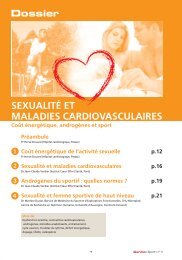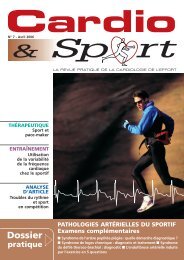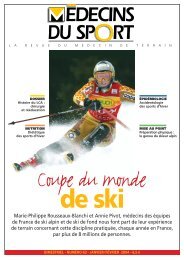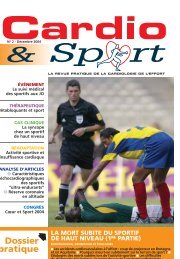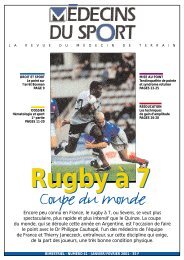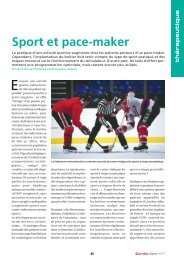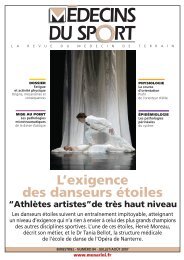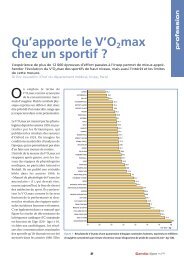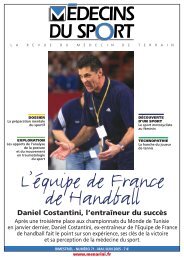Cardio et Sport - msport.net
Cardio et Sport - msport.net
Cardio et Sport - msport.net
- No tags were found...
You also want an ePaper? Increase the reach of your titles
YUMPU automatically turns print PDFs into web optimized ePapers that Google loves.
Que conseilleren pratique ?Il semble tout d’abord important derester en conformité avec les recommandationspubliées, qui sont en toutétat de cause opposables. Il faut doncsavoir jouer de diplomatie <strong>et</strong> raisonnerles patients excessifs dans leur pratiquesportive, <strong>et</strong> ne pas hésiter à leurexposer <strong>et</strong> opposer les bénéficesconnus d’une activité pratiquée à unniveau raisonnable, bénéfique à longterme, aux risques potentiels d’uneactivité inadaptée, à très haut risquecoronarien, voire possiblement létale(1/3 des thromboses de stents !) (22).Même si toute la lumière reste à fairesur certains des mécanismes desthromboses aiguës, sub-aiguës ouchroniques de certaines endoprothèses,la première chose est de recommanderun minimum de bon sens, àla fois pour le patient <strong>et</strong> l’angioplasticien.Les facteurs de risque de thrombosed’endoprothèses bien connus(23, 24), tels qu’un arrêt prématuré ouun oubli du traitement antiplaqu<strong>et</strong>tairesimple ou mixte, les implantationsdans le cadre des syndromescoronariens aigus, la longueur <strong>et</strong> lenombre d’endoprothèses implantées,les bifurcations, peuvent pour certainsDossierêtre en partie maîtrisés, en privilégiantnotamment la poursuite prolongée desprotocoles mixtes d’antiagrégants plaqu<strong>et</strong>taires(25).Pour ce qui est de la pratique physique<strong>et</strong> sportive <strong>et</strong> de son incidence éventuellesur le risque de thrombosed’endoprothèse coronaire, les quelquescas publiés dans la littérature ne perm<strong>et</strong>tentpas, aujourd’hui, d’avoir uneattitude alarmiste, bien au contraire.Il faut juste trouver le bon équilibredans la pratique <strong>et</strong>, surtout, déconseillerdes activités induisant unemajoration spontanée du risqu<strong>et</strong>hrombotique. ■DossierBibliographie1. Hambrecht R, Walther C, Mobius-Winkler S <strong>et</strong> al. Percutaneouscoronary angioplasty compared with exercise trainingin patients with stable coronary artery disease: a randomizedtrial. Circulation 2004 ; 109 : 1371-8.2. Lablanche JM, McFadden EP, Bonn<strong>et</strong> JL <strong>et</strong> al. Combined antiplatel<strong>et</strong>therapy with ticlopidine and aspirin. A simplifiedapproach to intracoronary stent management. Eur Heart J 1996 ;17 : 1373-80.3. Barragan P, Pi<strong>et</strong>ri P, Villain P <strong>et</strong> al. Antiplatel<strong>et</strong> therapyduring coronary endoprosthesis placement. Arch Mal CœurVaiss 1996 ; 89 : 1515-20.4. Morice MC, Serruys PW, Sousa JE <strong>et</strong> al. A randomized comparisonof a Sirolimus-eluting stent with a standard stent forcoronary revascularization. N Engl J Med 2002 ; 346 : 1773-80.5. Bauters C, Banos JL, Van Belle E <strong>et</strong> al. Six-month angiographicoutcome after successful repeat percutaneous interventionfor in-stent restenosis. Circulation 1998 ; 97 : 318-21.6. Gauliard E, Tavildari A, Eltchaninoff H <strong>et</strong> al. Resténose intrastentaprès implantation d’une endoprothèse nue ; suivi clinique<strong>et</strong> évolution selon le type de traitement appliqué. ArchMal Cœur 2006 ; 99 : 13-8.7. Wernick MH, Jeremias A, Carrozza JP <strong>et</strong> al. Drug-elutingstents and stent thrombosis: a cause for concern? Coron ArteryDis 2006 ; 17 : 661-5.8. Wijns WC, Krucoff MW. Increased mortality after implantationof first generation drug-eluting stents: seeing the smoke,where is the fire? Eur Heart J 2006 ; 27 : 2737-9.9. Oyabu J, Ueda Y, Ogasawara N <strong>et</strong> al. Angioscopic evaluationof neointima coverage: sirolimus drug-eluting stent versusbare m<strong>et</strong>al stent. Am Heart J 2006 ; 152 : 1168-74.10. Saf<strong>et</strong>y on drug-eluting stent: insights from m<strong>et</strong>a analysis. HotLine session I, World Congress of <strong>Cardio</strong>logy 2006, Barcelone.11. Maisel WH. Unanswered questions - drug-eluting stents andthe risk of late thrombosis. N Engl J Med 2007 ; 356 : 981-4.12. Yusuf S, Hawken S, Ounpuu S <strong>et</strong> al. Effect of potentiallymodifiable risk factors associated with myocardial infarctionin 52 countries (the INTERHEART study): case-control study.Lanc<strong>et</strong> 2004 ; 364 : 937-52.13. Piepoli MF, Davos C, Francis DP <strong>et</strong> al. Exercise training m<strong>et</strong>aanalysisof trials in patients with chronic heart failure (ExTra-MATCH). BMJ 2004 ; 328 : 189.14. Thompson PD, Balady GJ, Chaitman BR <strong>et</strong> al. Task Force 6:coronary artery disease. J Am Coll <strong>Cardio</strong>l 2005 ; 45 : 1348-53.15. Borjesson M, Assanelli D, Carre F <strong>et</strong> al. ESC Study Group of<strong>Sport</strong>s <strong>Cardio</strong>logy: recommendations for participation in leisure-timephysical activity and comp<strong>et</strong>itive sports for patientswith ischaemic heart disease. Eur J <strong>Cardio</strong>vasc Prev Rehabil2006 ; 13 : 137-49.16. Cerneca E, Simeone R, Bruno G, Gombacci A. Coagulationparam<strong>et</strong>ers in senior athl<strong>et</strong>es practicing endurance sportingactivity. J <strong>Sport</strong>s Med Phys Fitness 2005 ; 45 : 576-9.17. Weiss C, Seitel G, Bartsch P. Coagulation and fibrinolysisafter moderate and very heavy exercise in healthy male subject.Med Sci <strong>Sport</strong>s Exerc 1998 ; 30 : 246-51.18. Meurin P, Domniez T, Weber H <strong>et</strong> al. Occlusion of a coronaryendoprosthesis after a negative stress test. Arch MalCœur Vaiss 1999 ; 92 : 369-72.19. Goto Y, Sumida H, Ueshima K <strong>et</strong> al. Saf<strong>et</strong>y and implementationof exercise testing and training after coronary stenting inpatients with acute myocardial infarction. Circ J 2002 ; 66 : 930-6.20. Roffi M, Wenaweser P, Windecker S <strong>et</strong> al. Early exercise aftercoronary stenting is safe. J Am Coll <strong>Cardio</strong>l 2003 ; 42 : 1569-73.21. Parodi G, Antoniucci D. Late coronary stent thrombosisassociated with exercise testing. Cath<strong>et</strong>er <strong>Cardio</strong>vasc Interv2004 ; 61 : 515-7.22. Luscher TF, Steffel J, Eberli FR <strong>et</strong> al. Drug-eluting stent andcoronary thrombosis: biological mechanisms and clinical implications.Circulation 2007 ; 115 : 1051-8.23. Park DW, Park SW, Park KH <strong>et</strong> al. Frequency of and risk factorsfor stent thrombosis after drug-eluting stent implantationduring long-term follow-up. Am J <strong>Cardio</strong>l 2006 ; 98 : 352-6.24. Ong AT, Hoye A, Aoki J <strong>et</strong> al. Thirty-day incidence and sixmonthclinical outcome of thrombotic stent occlusion afterbare-m<strong>et</strong>al, sirolimus, or paclitaxel stent implantation. J AmColl <strong>Cardio</strong>l 2005 ; 45 : 947-53.25. Zimarino M, Renda G, De Caterina R. Optimal duration ofantiplatel<strong>et</strong> therapy in recipients of coronary drug-elutingstents. Drugs 2005 ; 65 : 725-32.21 <strong>Cardio</strong>&<strong>Sport</strong> • n°14




